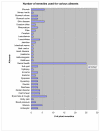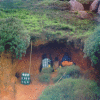Consensus of the 'Malasars' traditional aboriginal knowledge of medicinal plants in the Velliangiri holy hills, India
- PMID: 18371206
- PMCID: PMC2323365
- DOI: 10.1186/1746-4269-4-8
Consensus of the 'Malasars' traditional aboriginal knowledge of medicinal plants in the Velliangiri holy hills, India
Abstract
There are many vanishing cultures that possess a wealth of knowledge on the medicinal utility of plants. The Malasars of Dravidian Tamils are an indigenous society occupying the forests of the Western Ghats, South India. They are known to be exceptional healers and keepers of traditional aboriginal knowledge (TAK) of the flora in the Velliangiri holy hills. In fact, their expertise is well known throughout India as evidenced by the thousands of pilgrims that go to the Velliangiri holy hills for healing every year. Our research is the first detailed study of medicinal plants in India that considers variation in TAK among informants using a quantitative consensus analysis. A total of 95 species belonging to 50 families were identified for medicinal and general health purposes. For each species the botanical name, family, local name, parts used, summary of mode of preparation, administration and curing are provided. The consensus analysis revealed a high level of agreement among the informants usage of a particular plant at a local scale. The average consensus index value of an informant was FIC > 0.71, and over 0.80 for some ailments such as respiratory and jaundice. Some of the more common problems faced by the Malasars were gastrointestinal disorders, respiratory illness, dermatological problems and simple illness such as fever, cough, cold, wounds and bites from poisonous animals. We also discovered several new ethnotaxa that have considerable medicinal utility. This study supports claims that the Malasars possess a rich TAK of medicinal plants and that many aboriginals and mainstream people (pilgrims) utilize medicinal plants of the Velliangiri holy hills. Unfortunately, the younger generation of Malasars are not embracing TAK as they tend to migrate towards lucrative jobs in more developed urban areas. Our research sheds some light on a traditional culture that believes that a healthy lifestyle is founded on a healthy environment and we suggest that TAK such as that of the Malasars may serve toward a global lifestyle of health and environmental sustainability.
Figures







Similar articles
-
Ethnobotanical study of Kani tribes in Thoduhills of Kerala, South India.J Ethnopharmacol. 2014 Feb 27;152(1):78-90. doi: 10.1016/j.jep.2013.12.016. Epub 2014 Jan 3. J Ethnopharmacol. 2014. PMID: 24393788
-
Indigenous knowledge of medicinal plants used by the Reang tribe of Tripura state of India.J Ethnopharmacol. 2014 Feb 27;152(1):135-41. doi: 10.1016/j.jep.2013.12.037. Epub 2014 Jan 7. J Ethnopharmacol. 2014. PMID: 24412549
-
Inventorization of some ayurvedic plants and their ethnomedicinal use in Kakrajhore forest area of West Bengal.J Ethnopharmacol. 2017 Feb 2;197:231-241. doi: 10.1016/j.jep.2016.08.014. Epub 2016 Aug 30. J Ethnopharmacol. 2017. PMID: 27590732
-
Ethnodermatological use of medicinal plants in India: From ayurvedic formulations to clinical perspectives - A review.J Ethnopharmacol. 2022 Feb 10;284:114744. doi: 10.1016/j.jep.2021.114744. Epub 2021 Oct 14. J Ethnopharmacol. 2022. PMID: 34656666 Review.
-
A cross-cultural analysis of Jammu, Kashmir and Ladakh (India) medicinal plant use.J Ethnopharmacol. 2014 Sep 11;155(2):925-86. doi: 10.1016/j.jep.2014.06.029. Epub 2014 Jun 19. J Ethnopharmacol. 2014. PMID: 24952280 Review.
Cited by
-
Vascular Epiphytic Medicinal Plants as Sources of Therapeutic Agents: Their Ethnopharmacological Uses, Chemical Composition, and Biological Activities.Biomolecules. 2020 Jan 24;10(2):181. doi: 10.3390/biom10020181. Biomolecules. 2020. PMID: 31991657 Free PMC article. Review.
-
Folklore use of medicinal plants for the treatment of gynecological diseases in Pakistan-a review.Heliyon. 2024 Jul 19;10(15):e34869. doi: 10.1016/j.heliyon.2024.e34869. eCollection 2024 Aug 15. Heliyon. 2024. PMID: 39144941 Free PMC article. Review.
-
Valorizing the 'Irulas' traditional knowledge of medicinal plants in the Kodiakkarai Reserve Forest, India.J Ethnobiol Ethnomed. 2009 Apr 14;5:10. doi: 10.1186/1746-4269-5-10. J Ethnobiol Ethnomed. 2009. PMID: 19366462 Free PMC article.
-
Implementation of the Use of Ethnomedicinal Plants for Curing Diseases in the Indian Himalayas and Its Role in Sustainability of Livelihoods and Socioeconomic Development.Int J Environ Res Public Health. 2021 Feb 5;18(4):1509. doi: 10.3390/ijerph18041509. Int J Environ Res Public Health. 2021. PMID: 33562584 Free PMC article.
-
Ethnomedicinal Plant Knowledge of the Karen in Thailand.Plants (Basel). 2020 Jun 29;9(7):813. doi: 10.3390/plants9070813. Plants (Basel). 2020. PMID: 32610436 Free PMC article.
References
-
- Berkes F. Traditional ecological knowledge in perspective. In: Inglis JT, editor. Traditional Ecological Knowledge: Concept and Cases. Ottawa, Canada: International Program on Traditional Ecological Knowledge and International Development Research Centre; 1993. pp. 1–9.
-
- Martin JW. PhD thesis. Massachusetts Institute of Technology; 1995. Characterization of Neuropathological Shape Deformations.
-
- Drew JA. Use of traditional ecological knowledge in marine conservation. Conserv Biol. 2005;19:1286–1293. doi: 10.1111/j.1523-1739.2005.00158.x. - DOI
-
- Schultes RE. The role of the ethnobotanist in the search for new medicinal plants. Lloydia. 1962;25:257–266.
MeSH terms
Substances
LinkOut - more resources
Full Text Sources
Miscellaneous

